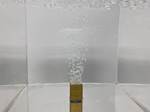Sintered, Porous Mold Steel Eliminates Gas Buildup
Molder’s World highlights its acclaimed Vortex self-venting mold steel, which uses a system of microscopic, interconnected pores to optimize molding processes.
Molder’s World Inc. draws attention to Vortex, a self-venting mold steel that it says is quickly becoming the industry standard. Specializing in self-venting mold steels since inception in 2001, Molder’s World is most well known as the preeminent distributor of Porcerax II prior to its discontinuation. Vortex, as its replacement, is claimed to be the most exciting development in the company’s 20+ year history.
Vortex uses a system of microscopic, interconnected pores with an average diameter of 7 µm (0.0003") interspersed throughout the steel. As pressure builds inside the mold, the gases present are forced directly through the Vortex, eliminating gas buildup, reducing injection pressure, lowering cycle times and gloss levels, and substantially reducing scrap and reject rates, enabling molders to save money in the process.
When compared to Porcerax II, Vortex is roughly 15% harder (43 HRC average), stronger (TR: 834 MPa) and less expensive than Porcerax II was prior to its discontinuation.
Though tool shops and molders may primarily identify Vortex for its use in speaker grill insert, interior automotive and medical applications, Vortex can be used in nearly every molding application where gas buildup is problematic. A variety of square, rectangle and round sizes, as well as self-venting core pins and plugs, are available.
Vortex is produced in the U.S. and is globally used in automotive, medical and commercial injection molding applications as well as lost-core wax molds.
Related Content
-
Advantages and Disadvantages of Copper and Graphite Electrodes
Both copper and graphite provide approximately the same end result, so it is important for a shop to consider the advantages and disadvantages of each material in order to discover what would work best in their shop floor environment.
-
Machining Center Spindles: What You Need to Know
Why and how to research spindle technology before purchasing a machining center.
-
Moldmakers Deserve a Total Production Solution
Stability, spindle speed and software are essential consideration for your moldmaking machine tool.















.png;maxWidth=300;quality=90)
_300x250 1.png;maxWidth=300;quality=90)
